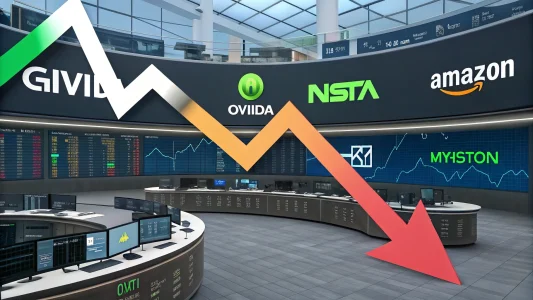Stocks look set to rally as lawmakers inch closer to ending the government shutdown. As a portfolio manager and planner, I watch these moments closely. They move markets and shape household budgets simultaneously. The message today is simple: a short-term agreement may arrive, and markets are reacting. But the underlying issues remain unsolved.
Table of Contents
ToggleWhat’s Driving the Surge in Confidence
Markets move on expectations. Investors are betting that Congress will pass a stopgap plan to reopen agencies and restart paychecks. That could reduce near-term uncertainty about growth, consumer spending, and credit markets. Even a temporary fix can boost risk appetite for a few days or weeks.
But a relief bounce is not the same as a durable trend. We have seen this script before. The shutdown standoff improves just enough to avoid lasting damage. Then the hard work gets kicked down the road, and we face the same drama months later. I want to explain what looks to be in the deal, why it helps in the short run, and what needs to change to prevent a repeat.
View this post on Instagram
What Lawmakers Appear to Agree On
Based on the outlines taking shape, the deal rests on three points that both parties can live with for now:
- Bring back furloughed workers with back pay and pause any new layoffs through September 26. That gets hundreds of thousands of workers back on the job and money flowing into local economies.
- Hold a December vote on extending Affordable Care Act subsidies. This is a core health care issue for many families and a key ask from Democrats. Republicans appear open to a vote, not a guarantee.
- Fully reinstate SNAP benefits so food assistance for low-income households continues without interruption.
These moves can calm nerves fast. They restart services, ease family stress, and help businesses that rely on government contracts and consumer spending. But they are stopgaps, not solutions.
Short-Term Relief, Long-Term Risk
Short-term fixes are better than no fixes. Yet they keep the cycle alive: a deadline, a standoff, a last-minute deal, and then a new deadline. Investors, workers, and small businesses pay the price in the form of uncertainty. Confidence suffers and planning becomes harder. That weighs on hiring and investment decisions.
Here’s the blunt truth: if the agreement only buys a few months, we could be right back here before year-end. Markets will trade with that in mind. You may see relief today, and volatility later if negotiations stall again.
Why These Three Points Matter
The three points in the outline touch the economy in clear ways:
1) Furloughed workers and back pay. Government workers are a sizable part of the labor force in many regions. When they miss paychecks, spending freezes. Restaurants, childcare providers, and local shops feel it. Back pay helps catch up on bills, but the missed weeks still hit cash flow. Rehiring and pausing layoffs through late September gives a window of stability.
2) ACA subsidies. Health insurance subsidies affect the disposable incomes of millions. Uncertainty around them forces families to choose between premiums and other needs. Even the promise of a vote can calm some of that fear. But a vote is not a policy outcome. If the vote slips or fails, we’re back to square one.
3) SNAP benefits. Food assistance supports vulnerable households and stabilizes grocery store demand. When benefits stop, families cut spending fast, and local economies feel it. Reinstating benefits helps prevent a deeper pullback in consumption among lower-income households.
What History Tells Us About Shutdowns
Shutdowns have a pattern. Workers get furloughed. Contractors wait for payments. Agencies pause permit issuance, inspections, and grant approvals. Data releases get delayed. Markets react to each headline and each deadline. The longer it lasts, the bigger the drag on growth. When it ends, some activity snaps back, but not all of it does. Missed restaurant meals or canceled travel rarely get made up later.
From a policy standpoint, shutdowns are a symptom of weak budget process rules. Without an enforcement mechanism that affects lawmakers personally, deadlines become bargaining chips rather than guardrails.
My Fix: Align Incentives With Outcomes
There is a simple way to reduce shutdown risk: link lawmakers’ pay to the status of the government’s operations. When the government shuts down, congressional pay should stop too—just like the other workers affected.
“The next time the government shuts down, Congress stops getting paid too, just like the other government workers.”
Some will argue this is a political gesture. I see it as a practical incentive. If the people making the decisions feel the same pain as the people living with the consequences, deadlines will look different. Negotiations will move faster. Compromise will come sooner.
There are constitutional details to sort out, and any change would need to be structured carefully. An escrow model is one path: pay is withheld during a shutdown and released only after government funding is restored. The goal is not punishment. It is alignment.
Investor Playbook for a Shutdown Relief Rally
Relief rallies can feel strong, but they often lack staying power if the policy outlook remains cloudy. Here is how I approach days like this:
1) Respect the tape, manage the risk. Markets tend to price better headlines before the ink dries. Chasing a big gap up after a political headline can be risky. I prefer to let the dust settle before making big moves.
2) Focus on cash flows and credit. When government operations restart, contractors and agencies resume payments, which can ease short-term credit stress. That helps smaller suppliers and service firms. If you hold bonds or bond funds, watch credit spreads. They are an early signal of stress or relief.
3) Look at consumer-sensitive names. With back pay and SNAP restored, spending at the low and middle income levels may stabilize. Discount retailers, grocers, and certain services could see a lift. The size of the boost depends on how long the shutdown lasted and whether other headwinds are present.
4) Maintain your core allocation. Political noise is frequent. Your long-term mix should not swing with each headline. Rebalance if the move creates drifts outside your targets, but avoid turning a relief rally into a strategy shift.
5) Watch the new deadlines. If the agreement punts decisions into December, set a reminder. Markets may price that risk ahead of time. Volatility often rises as the next deadline approaches.
Policy and Household Budgets
Policy choices show up in family budgets fast. Anyone who missed a paycheck feels the stress for months. Late fees, interest charges, and reworked schedules don’t just vanish when back pay arrives. Health coverage choices, especially for families using ACA subsidies, shape the year’s finances. Food assistance helps prevent deeper hardship, but stability requires consistency.
As a planner, I encourage clients who face irregular income to build a larger cash buffer when possible. Aim for a few months of essential expenses. If you are a contractor working on government contracts, consider diversifying your client base. For households using SNAP or ACA subsidies, keep copies of notices and communicate early with providers when payments are disrupted. A prompt call can sometimes prevent service cuts or late fees.
What Could Go Wrong From Here
Even if markets rise today, several risks remain:
- Short window. If the deal expires in a few months, we face another cliff.
- Policy slippage. A promised vote on subsidies may get delayed or watered down.
- Economic spillovers. Contractors and small firms may suffer lasting cash flow damage that doesn’t fully reverse.
- Investor complacency. A big rally can mask fragile fundamentals and lead to mispriced risk.
Why Markets Love Certainty
Investors don’t require perfect outcomes. They need clarity. A known path, even if imperfect, allows businesses to plan and families to spend. That is why shutdowns are so damaging. They inject doubt into hiring, capital spending, and credit decisions. When leaders set a schedule and stick to it, markets reward that discipline with lower volatility and tighter credit spreads.
The Leadership Test
This moment is a test for both parties. Short-term fixes are the start, not the end. Real progress would include a reliable budget schedule, fewer cliffs, and genuine work on health and nutrition programs that families depend on. Voters and markets are watching.
As the head of LifeGoal Wealth Advisors, I work to separate signal from noise. Today’s signal is that a deal is near and risk assets may rally. The noise is the chorus of finger-pointing that distracts from a durable solution. We can do better than lurching from deadline to deadline.
Final Thought
Bringing back workers, resuming SNAP, and setting a vote on health subsidies will ease near-term strain. I welcome that progress. But this cycle will repeat unless the incentives for the people who decide our budget path change. If shutdowns pause pay for lawmakers the same way they do for other workers, we would see faster agreements and fewer standoffs.
For investors, enjoy the relief, manage risk, and keep your plan steady. For policymakers, pass the stopgap, then fix the process. That is how we turn a market bounce into lasting confidence.

















